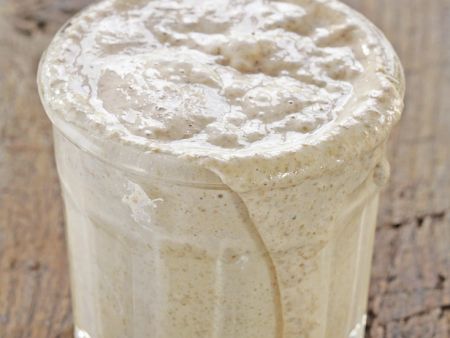back to cookbook
Sourdough Boules
0
Average: 0 (0 votes)
(0 votes)
Rate recipe
Show all reviews

Difficulty:
advanced
Difficulty
Preparation:
5 h.
Preparation
ready in 10 d. 5 h.
Ready in
Ingredients
for
1
- For the starter
- 3 ⅓ cups white Bread flour
- 3 ⅓ cups whole-wheat bread flour
- For the sponge
- ⅜ cup natural Sourdough starter
- 1 ⅔ cups Bread flour (or whole wheat bread flour)
- 1 ⅓ cups warm water
- For each loaf
- 1 ⅔ cups Bread flour (or whole wheat bread flour)
- 1 Tbsp olive oil
How healthy are the main ingredients?
olive oilback to cookbook
print shopping list
Preparation steps
1.
Begin with the starter. In a large bowl, mix 100 g strong bread flour with 100-150 ml warm water to make a batter.
2.
Beat it for a few minutes to incorporate air, then cover with clear wrap and leave in a warm place.
3.
Leave until bubbles develop and the mixture starts to ferment. This could take few hours or a few days.
4.
Your starter now needs regular feeding. Begin by whisking in another 100 g of fresh flour and enough water to retain that thick batter consistency. Leave it again.
5.
24 hours later, scoop out and discard half of the starter and stir in another fresh 100 g flour and some more water.
6.
Repeat this discard-and-feed routine every day, maintaining the sloppy consistency and keeping your starter at room temperature and after 7-10 days you should have something that smells yeasty. It's now ready to bake with.
7.
The night before you want to bake your loaf, create the sponge: take about 100 ml of your active starter, and combine it with 250 g fresh flour and 300 ml warm water in a large bowl.
8.
Mix well then cover with clear wrap and leave overnight. In the morning, it should be clearly fermenting - thick, sticky and bubbly.
9.
Now make your loaf: add a fresh 300 g flour to the sponge, along with 1 tbsp oil, 2 tsp salt.
10.
Mix it all together with your hands. You should have a fairly sticky dough.
11.
Turn out the dough on to a lightly floured surface and knead for 10 minutes until smooth and silky..
12.
Put the dough in a lightly oiled bowl and turn it so it gets a light coating of oil. Cover with clear wrap, or put the bowl inside a plastic bag, and leave to rise all day (or overnight) in a warm place, until it has more or less doubled in size and feels springy when you push your finger gently into it.
13.
Knock it back on a lightly floured surface.
14.
Line a medium-sized, fairly shallow-sided bowl with a clean tea towel, then dusting it with flour. Place your round of dough inside, cover again with a clean plastic bag and leave to rise, in a warm place this time, until roughly doubled in size. This will take 1-4 hours.
15.
Heat the oven to 240°C (220C fan oven) 475F gas 9 with a flour dusted baking tray. Half fill a roasting tin with boiling water and place at the bottom of the oven.
16.
Tip the dough upside down, on to the sheet. Slash the top of the loaf a few times with a very sharp, serrated knife.
17.
Bake for 15 minutes, reduce the heat to 200°C (180C) 400F gas mark 6, bake for a further 25-30 minutes, or until the well-browned loaf vibrates and sounds hollow when you tap its base.
Related Recipes
Spring Cookbooks
Get Fit!
Simple, But Good
Weeknight Dinners
Tags
Popular Cookbooks
Related Recipes
App Download
Recipe of the Day
Popular Cookbooks
Video of the Week
Current Recipe Search
Cookbooks of the week
























































